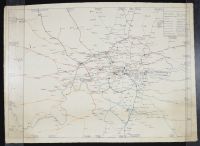Hand Drawn Tube Map
Halfsheet
pre-Harry Beck London Underground map, likely dating from the mid-to-late 1920s. These maps were geometrically accurate, with the railway lines overlaid on a street map. This approach made the central London area appear cluttered and difficult to read, as the stations were geographically close together.
Key Characteristics of the Map Style
Geographical Accuracy: Unlike the modern, topological map, this version prioritizes showing stations in their actual physical locations relative to each other and the River Thames.
Cluttered Central Area: The density of stations and winding lines in the city center made the map complex and difficult for passengers to use effectively.
Fred Stingemore's Influence: Designers like Fred Stingemore, who worked in the 1920s, started to introduce some artistic license by slightly expanding the central area for clarity, a step towards the modern design.
Harry Beck's Revolution: This style was eventually replaced by Harry Beck's innovative, circuit-diagram-based design, first published in 1933. Beck's design used straight lines and 45-degree angles, dispensing with geographical accuracy to prioritize connectivity and readability, a design that became the standard for transport maps worldwide.
pre-Harry Beck London Underground map, likely dating from the mid-to-late 1920s. These maps were geometrically accurate, with the railway lines overlaid on a street map. This approach made the central London area appear cluttered and difficult to read, as the stations were geographically close together.
Key Characteristics of the Map Style
Geographical Accuracy: Unlike the modern, topological map, this version prioritizes showing stations in their actual physical locations relative to each other and the River Thames.
Cluttered Central Area: The density of stations and winding lines in the city center made the map complex and difficult for passengers to use effectively.
Fred Stingemore's Influence: Designers like Fred Stingemore, who worked in the 1920s, started to introduce some artistic license by slightly expanding the central area for clarity, a step towards the modern design.
Harry Beck's Revolution: This style was eventually replaced by Harry Beck's innovative, circuit-diagram-based design, first published in 1933. Beck's design used straight lines and 45-degree angles, dispensing with geographical accuracy to prioritize connectivity and readability, a design that became the standard for transport maps worldwide.
Disclaimer
The object and/or subject of this report is private property. This page is for informational purposes only. Unless clearly stated otherwise, all conservation and restoration has been performed by Poster Mountain (PM) or Los Angeles Paper Group (LAPG)I) PM-LAPG has not knowingly withheld any significant information from its evaluation report and to the best of its knowledge all statements and evaluations in this report are true and correct.
II) PM-LAPG stated in the Evaluation Report its own personal, unbiased and professional analysis, opinions and conclusions, which are subject to the assumptions and limited conditions in this evaluation report as set forth hereinabove.
III) PM-LAPG has no present or prospective interests in the property which is the subject matter of this report and it has no present or prospective personal interests or bias with respect to the participants in this matter.
IV) PM-LAPG and its employment and/or compensation for performing this evaluation or any future anticipated evaluation was not conditioned on any agreement or understanding, written or otherwise, that it would report (or present analysis in support) as predetermined specific authenticity, a predetermined evaluation that favors the cause of any party or the attainment of any specific result or occurrence of a specific subsequent event, such as value or marketability.
V) PM-LAPG prepared all opinions and conclusions about the subject property that were set forth in this Evaluation Report. If it has relied on significant evaluation assistance from any individual or individuals in the performance of this evaluation or the appropriation of this evaluation report, PM-LAPG has named such individuals and disclosed the specific task performed in this evaluation report. PM-LAPG certifies that any individual so named is qualified to the same extent as PM to perform the task. PM-LAPG has not authorized anyone to make a change to any item in this evaluation report, therefore, any change made to this evaluation is unauthorized and PM-LAPG will not take responsibility for it.
VI) The Client may not disclose or distribute this Evaluation Report to any potential purchasers of the subject property without first obtaining PM-LAPG's prior written consent. This consent must be obtained before this evaluation report may be disclosed or distributed to any other party, including, but not limited to, the public through advertising, public relations, news, sales, or other media.


